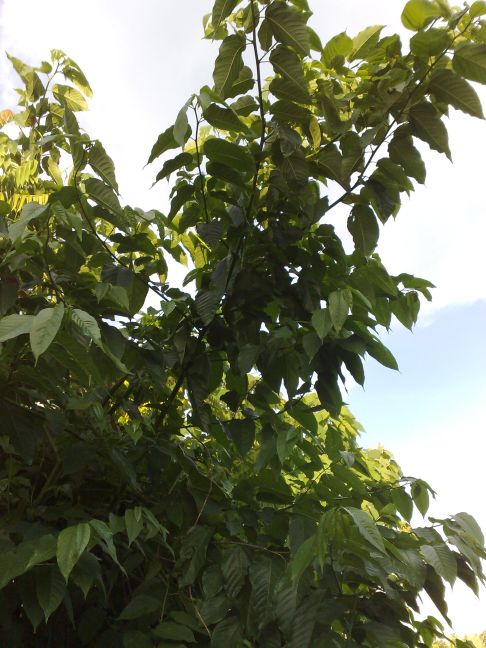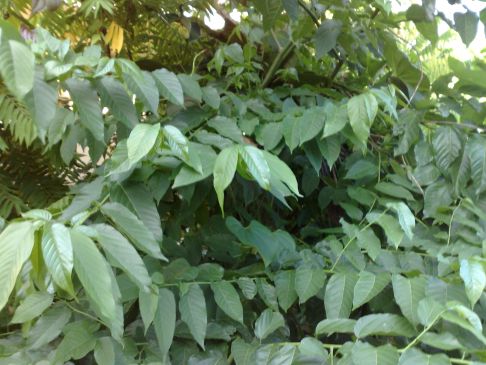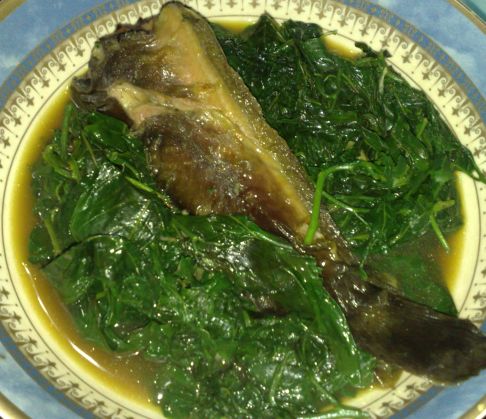Alukon or alokon (allaeanthus glaber; also called bungon and baeg [in Pangasinan]) is more known for its flowers or flowerettes as a popular "mix" in some vegetable dishes, notably buridibod or in the simple dinengdeng, and in the quintessential pinakbet.
But besides its more popular flower, the leaves of the alukon tree is also edible and is equally great for that perfect dinengdeng of leafy veggie medley, or as a solo inabraw nga alukon (I used "inabraw" here because, usually, it is the term used when the dinengdeng is comprised mostly, or wholly, of leaves). I have yet to see alukon leaves being sold in the market, though. Maybe because some folks are not used to it or don't know that the leaves are edible and palatable as well. The leaves, of course, is abundant even when the tree is not in flowering/blooming season. As the tree is usually have its branches cut to gather the flowers, after a few days, fresh sprouts will bud that promise beautiful tender leaves for alukon lovers to consume. A small alukon tree grown in your backyard can supply you bountiful leaves all year round. Just cut the branches when all its leaves are matured to enable new branches to bud. Needless to say, I might swear I even love the leaves more than the flowers because it represent a true green leafy veggie for a truly hearty dinengdeng or inabraw. I just love the alukonness of it, the sweet sabeng or pas-eng--that distinct aroma that veggie lovers adore, and the unique tartness of it that caters to a genuinely Ilokano fondness for leafy green vegetable stews.



So, I cooked my inabraw nga alukon just as simply as boiling it in bugguong. I just took care of it not to overcook the tender leaves. And few moments before it is done, I placed atop the boiling stew a grilled paltat (catfish) as a sagpaw (add-on). Let the steam engulf the sagpaw for some more moments and then put off the fire and serve the inabraw immediately.
What comes next is a lovely sight and a heavenly scent is wafting--the yellow soup (the leaves turn the broth yellowish as is with other vegetable leaves like utong [sitaw, cowpea] leaves) tantalizing your palate.


It's so good with your steamed rice, the broth makes a perfect labay that turns your rice like a java rice!

Ahh, the simplicity of Ilokano gastronomy!
(Originally blogged January 30, 2010)














may i know what's the Tagalog name of the Alukon? my fathere never taught me the Ilokano language and words for all the things specially veggie so i would like to know. thanks.
ReplyDeletehimbabao
ReplyDeletehimbabao
ReplyDeleteWhat is the real scientific name for Alukon?
ReplyDeleteso far I've seen different ones
let us say Himbabao is Alleaenthus luzonicus
for Alukon I see Broussonetia luzonica
and what you said, halp
There are times when alukon flowerettes are sold in the market here in Koronadal City. Alukon sells like hot cake. We Ilokanos love it so much that as soon as we see it displayed we buy it. It disappears in the twinkling of an eye, so they say.
ReplyDeleteHi, may I ask if someone knows where to buy or look for alukon leaves? Near manila or zambales
ReplyDelete